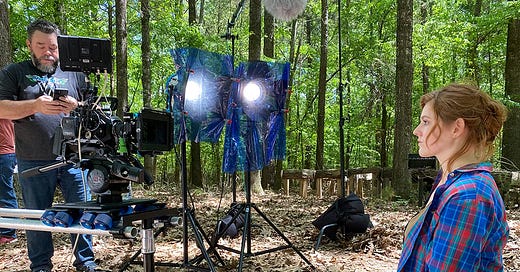In last week’s post I went into some detail about how, a few years ago, a barrage of obstacles were thrown in my way as I tried to make a short film, forcing me to postpone, pivot, write something new, then postpone again, until finally...
…I directed Miss Responsibility, a comedy about Claire, a rich party girl who has to prove to her Daddy that she can be a more mature adult.
The main thing I learned through that experience is that if you want to make any kind of film at any level, regardless of size or budget, a certain amount of patience and perseverance is required.
As a continuation of last week’s story I thought I might write about my approach in making Miss Responsibility and why I took a slightly different tack.
If you like my work here, why not consider helping me keep my Internet connection active? That way, I can continue to deliver good stuff straight to your inbox.
I consider myself an extremely organized and detail-oriented person. I never go into a shoot without a detailed shot list and schedule. I want everyone to know (including myself) what’s happening and when, so that we can all be prepared in case things go sideways. It’s a great way to work. It brings everyone together on the same page so there’s a clear sense of direction and purpose. I always want my cast and crew to have fun on set, but like I often say, the “fun” happens when everyone is prepared.
However, with Miss Responsibility, I wanted to approach the shoot with a different mindset. I wanted to recapture the feeling of spontaneity and improvisation I felt when I was a young student filmmaker. Back then, I would simply call up a few friends, ask if they wanted to get together to make a movie, grab a camera, and go shoot something. There was a certain energy we all had when our scripts were simply rough outlines and we just made it up as we went along, all the while taking turns to run the camera, hold the mic, or act.
So, I wanted Miss Responsibility to balance both sides of that coin; I wanted the structure of a polished script and a firm direction of where we were all going, but I wanted the shoot itself to be loose and nimble. I didn’t want to force myself into a strict shot list or a firm shooting schedule. I wanted to explore ideas as they came to us while on set.
The obvious question, then, is “Why do this?”
Why go against your natural inclinations and approach a shoot differently than what you’re accustomed to? For me, I think it’s important to challenge myself from time to time; to lean in to that which makes me a little uncomfortable. I produce short films not only because I have a passion for filmmaking, but because I want to improve my craft in some way. So, before I move on to the next project, I select a particular aspect of the process that I want to focus my efforts on.
After directing my short Final Hit, I wanted to focus on a complete tonal shift. Could I create a family-friendly short film full of heart, suitable for all ages? The result was Big and Tall.
Following Big and Tall I wanted to improve my dialogue skills. Could I write a comedy, centered on a conversation between only two people, confining myself to one location (and, in fact, one table), and make it funny and entertaining? The result was Hangry.
You get the idea.
I believe that the only way to improve as a filmmaker is not only to make films, but to try different techniques. This will greatly expand your skill set and your confidence.
And you will learn something about yourself in the process.



